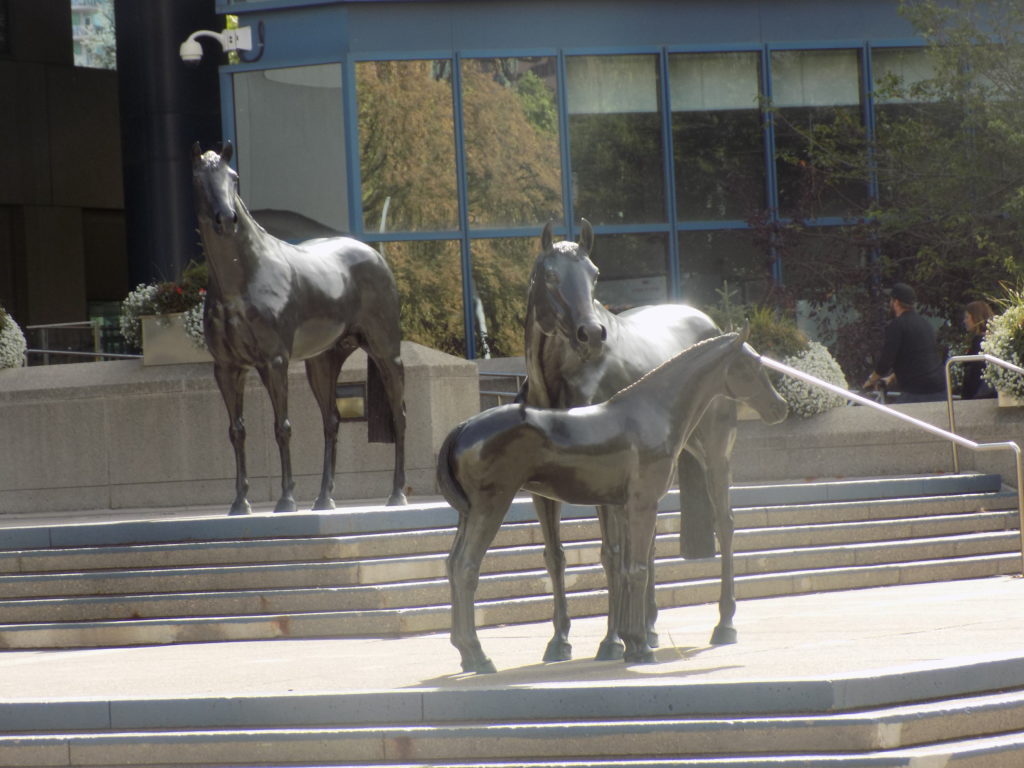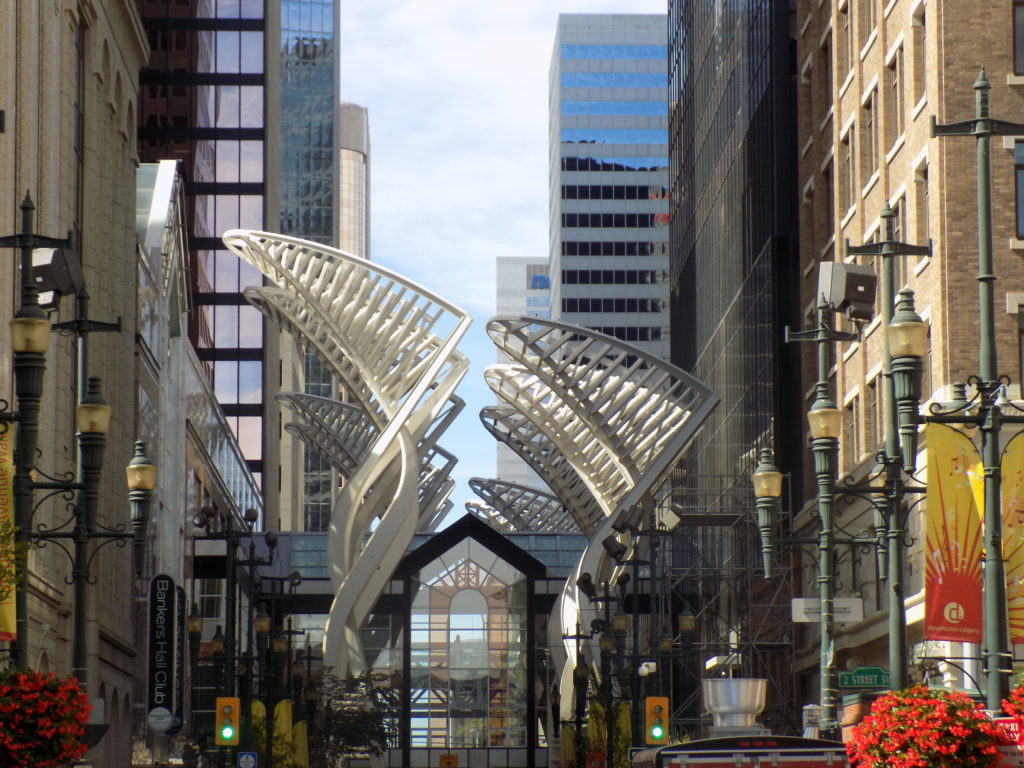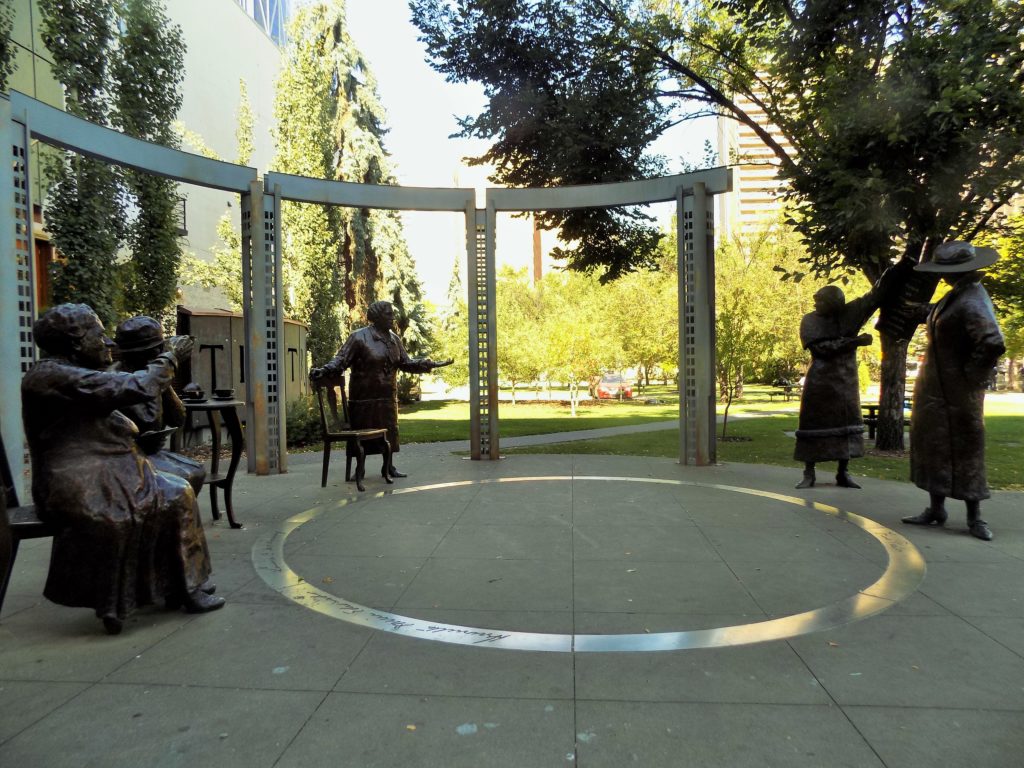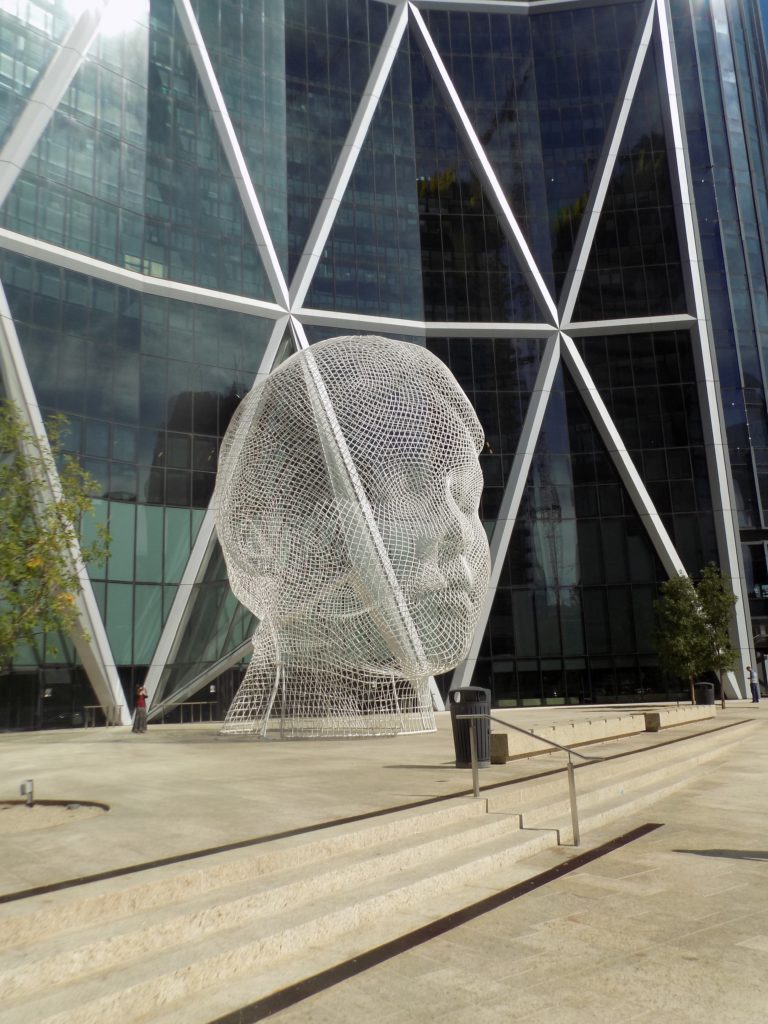I didn’t have any particular plan in mind when I set out from the NMC. It was mostly sunny and warm but not hot so I thought simply wandering – at least to start – might be a pleasant way to stroll around this relatively flat city.
Family of Horses.
As it happened, the first piece of art on my list – Family of Horses – was nearby. Located in front of City Hall, the horses were a gift on behalf of the horse industry from Spruce Meadows – said to be one of Canada’s best equestrian facilities. In addition to representing the important role horses played in Calgary’s development, the work, with the stallion overlooking the mare and foal is meant to symbolize, “the bond of kinship and strength among families.”
The Conversation and Trees.
From the Family of Horses it was just a short walk up Stephen Avenue – the pedestrian section of 8 Avenue SW – past the Olympic Park and Calgary Tower to one of the better known and older pieces of Calgary’s public art – The Conversation. It’s a life size work by Willima McElcheran of two businessmen meeting on the street. Beyond that, the viewer can project their interpretation of the piece. Is this a chance meeting or one that was planned? Are they making a deal or having a debate? Waiting to snap a picture with no people, I watched as some passers-by stopped to eavesdrop or perhaps join in. (For me, it’s enough that they’re both hatted.)
Farther along the Stephen Avenue Galleria is the work known as the Trees. These are 10 sculptures of two heights – one set rises 21-metres from its base and the other 26-metres. These particular trees are not merely visually interesting, they’re functional, too. They actually minimize the strength of wind gusts blowing between the buildings along Calgary’s only pedestrian street.
The Famous Five – Women Are Persons.
On my first trip along Stephen Avenue I walked past a very, very famous monument because it was surrounded by a swarm of tourists. When I reached it for a second time, I thought I was in luck because there was only a small group of five middle-aged Asians – either Korean or Chinese by my linguistic guesstimate – preparing to take pictures of the statues. My assessment regarding my luck turned out to be terribly wrong.
Led by Henrietta Edwards and Emily Murphy, a group of five women filed a case in August 1927 with the Canadian Supreme Court asking it to determine whether the word “persons” in Section 24 of the British North America Act of 1867 included female persons who could thus take a seat in the Canadian Senate. On 24 April 1928, the Court ruled against the five women. The last line of the judgment reads, “Understood to mean ‘Are women eligible for appointment to the Senate of Canada,’ the question is answered in the negative.” However, the British Judicial Committee of the Privy Council overturned the decision on 18 October 1929 and. on that date, Canadian women became persons.
(Canadian women {with the exception of First Peoples women} had gained suffrage in 1917. The Nineteenth Amendment to the United States Constitution granting women full suffrage was passed by the Senate in 1919 and ratified by the requisite three-fourths of the states on 18 August 1920 making the United States the twelfth country to grant women the right to vote. The first country to grant women the vote was New Zealand in 1893 – making it the only country that allowed women to vote before the turn of the twentieth century. Australia, Finland, Norway, Denmark, Canada, Austria, Germany, Poland, Russia, and the Netherlands all preceded the United States. Sweden, in 1921, became the last Scandinavian country to allow women’s suffrage while Britain and Ireland didn’t grant women the right to vote until 1928.)
I can assure you that, however long you needed to read the two preceding paragraphs, my wait to take a photograph was considerably longer. By the time the small group of Asians – three men and two women – finished taking all their pictures, I felt as though I could have read a brief biography of each of these icons of Canadian history. Each of the tourists felt the need to have their picture taken individually with each of the five statues. Then the two couples had to repeat the cycle as a couple. This might have been tolerable had one of the men not apparently fancied himself an artiste. He spent several minutes fussing over each picture of the woman I assumed was his wife making certain she was in just the position he wanted. If she so much as bent a knee or turned her foot he’d toss up his hands in frustration and start anew. They seemed unconcerned by my hovering presence though I’d hoped my body language had communicated my desire to take a picture without them in it. In the end, my patience had its reward.
Wonderland.
One of the most interesting works of the public art project sits in front of the Bow Building. I don’t know whether the building is named for its crescent shape or for the Bow River that we encountered in the first days of the trip in Banff National Park and which flows through the center of Calgary. Regardless, occupying the plaza outside the building is a 12-meter-tall bent wire sculpture of a girl’s head. Named Wonderland, the creation by Spanish sculptor Jaume Plensa, it’s intended to symbolize the hopes and dreams of young Albertans. Perhaps even more than The Conversation, this work invites interaction.
I particularly like the Calgary Herald’s description from July 10, 2012:.
Anna is coming to Calgary this fall. She’s 12, from northern Spain, parts her hair down the middle and stands about four storeys tall, from the neck up.
Her giant head, in thick wire mesh, is Wonderland by Jaume Plensa.
The interactive sculpture will be taller than the Family of Man statues by the former public school board headquarters, nearly as soaring as the white Trees sculptures by Bankers Hall, but will appear dwarfed beneath 58-storey Bow tower.
As he presented his design Monday, Plensa cracked that if Norman Foster’s skyscraper is the big blue curve in the tower’s logo, Wonderland is the small red dot.
“Such a huge responsibility to be the small red dot, in between the Calgary community and his beautiful building,” the Barcelona-based artist said. “My piece is not at all trying to compete in terms of the scale of the architecture. I’m trying to link the people using the plaza with the city.”
We’ll continue to the aforementioned Family of Man sculpture in the next and final post for this trip.




